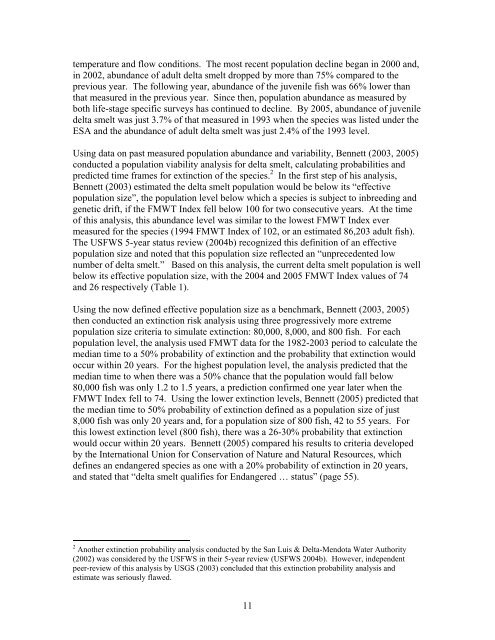ESWR page - Endangered Species & Wetlands Report
ESWR page - Endangered Species & Wetlands Report
ESWR page - Endangered Species & Wetlands Report
You also want an ePaper? Increase the reach of your titles
YUMPU automatically turns print PDFs into web optimized ePapers that Google loves.
temperature and flow conditions. The most recent population decline began in 2000 and,<br />
in 2002, abundance of adult delta smelt dropped by more than 75% compared to the<br />
previous year. The following year, abundance of the juvenile fish was 66% lower than<br />
that measured in the previous year. Since then, population abundance as measured by<br />
both life-stage specific surveys has continued to decline. By 2005, abundance of juvenile<br />
delta smelt was just 3.7% of that measured in 1993 when the species was listed under the<br />
ESA and the abundance of adult delta smelt was just 2.4% of the 1993 level.<br />
Using data on past measured population abundance and variability, Bennett (2003, 2005)<br />
conducted a population viability analysis for delta smelt, calculating probabilities and<br />
predicted time frames for extinction of the species. 2 In the first step of his analysis,<br />
Bennett (2003) estimated the delta smelt population would be below its “effective<br />
population size”, the population level below which a species is subject to inbreeding and<br />
genetic drift, if the FMWT Index fell below 100 for two consecutive years. At the time<br />
of this analysis, this abundance level was similar to the lowest FMWT Index ever<br />
measured for the species (1994 FMWT Index of 102, or an estimated 86,203 adult fish).<br />
The USFWS 5-year status review (2004b) recognized this definition of an effective<br />
population size and noted that this population size reflected an “unprecedented low<br />
number of delta smelt.” Based on this analysis, the current delta smelt population is well<br />
below its effective population size, with the 2004 and 2005 FMWT Index values of 74<br />
and 26 respectively (Table 1).<br />
Using the now defined effective population size as a benchmark, Bennett (2003, 2005)<br />
then conducted an extinction risk analysis using three progressively more extreme<br />
population size criteria to simulate extinction: 80,000, 8,000, and 800 fish. For each<br />
population level, the analysis used FMWT data for the 1982-2003 period to calculate the<br />
median time to a 50% probability of extinction and the probability that extinction would<br />
occur within 20 years. For the highest population level, the analysis predicted that the<br />
median time to when there was a 50% chance that the population would fall below<br />
80,000 fish was only 1.2 to 1.5 years, a prediction confirmed one year later when the<br />
FMWT Index fell to 74. Using the lower extinction levels, Bennett (2005) predicted that<br />
the median time to 50% probability of extinction defined as a population size of just<br />
8,000 fish was only 20 years and, for a population size of 800 fish, 42 to 55 years. For<br />
this lowest extinction level (800 fish), there was a 26-30% probability that extinction<br />
would occur within 20 years. Bennett (2005) compared his results to criteria developed<br />
by the International Union for Conservation of Nature and Natural Resources, which<br />
defines an endangered species as one with a 20% probability of extinction in 20 years,<br />
and stated that “delta smelt qualifies for <strong>Endangered</strong> … status” (<strong>page</strong> 55).<br />
2 Another extinction probability analysis conducted by the San Luis & Delta-Mendota Water Authority<br />
(2002) was considered by the USFWS in their 5-year review (USFWS 2004b). However, independent<br />
peer-review of this analysis by USGS (2003) concluded that this extinction probability analysis and<br />
estimate was seriously flawed.<br />
11
















